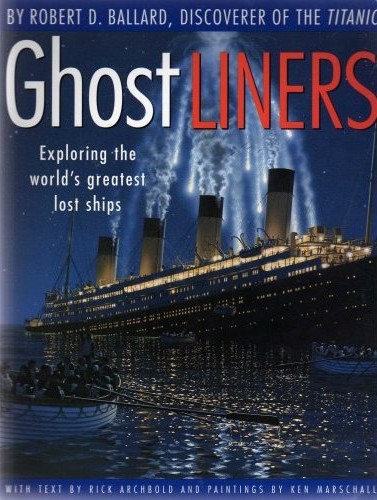 I’ve mentioned before that my daughter, Amber, who is 11, loves non-fiction, but it can be tough to find books perfect for her. Ghost Liners definitely fit the bill.
I’ve mentioned before that my daughter, Amber, who is 11, loves non-fiction, but it can be tough to find books perfect for her. Ghost Liners definitely fit the bill.
Robert Ballard is an explorer, an adventurer whose interests lay under the water. Beginning with the famous Titanic, he tells of five great ocean liners that sunk. Amber had actually read an excerpt from the book, the chapter about the Titanic in her reading class last year, and found it fascinating, which is what made us read the book together.
Ballard doesn’t just give us a dry history of the ships- when they were built, what happened to make them sink. He makes us see the ships in their glory, know what it felt like in the last minutes of the wreck, and shows us eerie underwater photos of what remains. Some of the stories of rescues and losses are touching, and for each ship Ballard gives us a personal story.
The ships that are focussed on are the Titanic of course, the Empress of Ireland which I had never heard of, the Lusitania, the H.M.H.S. Brittanic, and the Andrea Doria. Each ship is unique as is each shipwreck, but Ballard does see a commonality.
Maybe they remind us of a truth that seems more important than ever as we reach the end of the twentieth century: Whenever human beings put too much faith in technology, the regret having done so. Each of the ghost liners chronicled in this book sank, at least in part, because the people who built and sailed them believed they were unsinkable. (pg. 60-61)
The illustrations, both the photos and the paintings by Ken Marschall, were a great addition to the text. They let us see what he was talking about, gave us a fuller picture.
This book presents a great balance between history and technology, between the stories of the ships and the modern exploration of their wreck. In the back there’s a list of suggested further reading, and we’ll definitely be learning more about these fascinating ocean liners.
Purchase at Amazon.
4 out of 5 stars
Category: Middle school – history, Middle school – exploration
64 pages
First published September 1, 1997
Book source: library
Nice that she likes non-fiction 🙂 I seldom read non-fiction even though there are many good books out there
I try to encourage it. At least the books get more interesting as she gets older. When she was younger it was just one animal book after another.
That does sound like a fascinating book!
Aidan has been obssessive about ships ever since he saw his first iron ore ship. I think he would enjoy this one.
Amber liked it so much she thinks we need to buy a copy. We borrowed it from the library this time.
I have to get hold of this book! I have been interested in the Titanic every since I was a kid. It’s great that your daughter can read non-fiction – I can only read maybe 1 non-fiction in a month..
I don’t read much non-fiction either, but she prefers it.
It is funny how with nonfiction you either love it or not…love the photo…
Hopefully neither one of us, we will be locking ourselves out of the house this week.
Amen!
This sounds like an interesting read.
I read Ballard’s book that he wrote just about the sinking of the Titanic and really enjoyed it. Looks like a great book for kids.